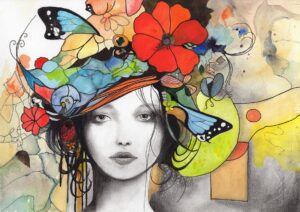 Art Nouveau, a decorative and highly stylised artistic movement that emerged in the late 19th and early 20th centuries, continues to inspire contemporary artists and designers today. Contemporary Art Nouveau, while deeply rooted in its historical predecessor, has evolved to incorporate modern materials, digital technology, and diverse cultural influences. This article explores the origins of Art Nouveau, its defining characteristics, notable artists, and how contemporary interpretations both differ from and pay homage to the classic style.
Art Nouveau, a decorative and highly stylised artistic movement that emerged in the late 19th and early 20th centuries, continues to inspire contemporary artists and designers today. Contemporary Art Nouveau, while deeply rooted in its historical predecessor, has evolved to incorporate modern materials, digital technology, and diverse cultural influences. This article explores the origins of Art Nouveau, its defining characteristics, notable artists, and how contemporary interpretations both differ from and pay homage to the classic style.
Art Nouveau, meaning “New Art” in French, emerged in the late 19th century as a reaction to the rigid academic art and industrialisation of the time. It flourished between 1890 and 1910, spreading across Europe and North America, influencing architecture, design, painting, and decorative arts. The movement sought to break away from traditional artistic constraints by embracing organic forms, flowing lines, and intricate details inspired by nature.
Key figures in the Art Nouveau movement include:
Alphonse Mucha (1860–1939): A Czech artist known for his elaborate posters featuring flowing-haired women surrounded by intricate floral patterns.
Gustav Klimt (1862–1918): An Austrian painter whose works, such as The Kiss, blend Art Nouveau’s organic forms with elements of Symbolism.
Hector Guimard (1867–1942): A French architect best known for designing the Paris Métro entrances, which epitomize Art Nouveau’s curvilinear aesthetic.
Louis Comfort Tiffany (1848–1933): An American artist and designer famous for his stained glass works, which exemplified the movement’s emphasis on craftsmanship and nature-inspired beauty.
The defining characteristics of classic Art Nouveau include:
Organic Forms: Flowing, sinuous lines inspired by plants, flowers, and the human figure.
Asymmetry: A departure from rigid geometric structures in favor of dynamic, fluid compositions.
Ornamentation: Highly decorative elements integrated into architecture, furniture, and art.
Use of New Materials: Emphasis on glass, iron, and ceramics to create elaborate, innovative designs.
Total Art Style (Gesamtkunstwerk)**: A holistic approach where architecture, furniture, and interior design were unified in artistic harmony.
Contemporary Art Nouveau embraces the core aesthetics of the original movement while integrating modern technology, materials, and cultural diversity. Some key ways it has evolved include:
Modern artists utilize digital tools, including 3D modeling and digital painting, to create intricate, nature-inspired designs reminiscent of Art Nouveau. Graphic designers often incorporate swirling motifs and organic patterns in digital illustrations and branding.
Whereas classic Art Nouveau embraced handcrafted materials, contemporary artists incorporate sustainable and recycled materials. Modern architects use glass, metal, and biodegradable elements to create innovative structures that still reflect the ornate beauty of the original movement.
Classic Art Nouveau was primarily a European movement, but its modern counterpart draws inspiration from global cultures. Artists blend Art Nouveau’s flowing lines with Asian, African, and indigenous artistic traditions, creating a more diverse and inclusive aesthetic.
Contemporary street artists and muralists reinterpret Art Nouveau’s intricate line work in public spaces. Notable artists such as James Jean and Audrey Kawasaki fuse Art Nouveau’s organic forms with modern, surreal elements in their paintings and illustrations.
Many contemporary fashion designers incorporate Art Nouveau motifs into textiles, embroidery, and jewelry. Interior design has also seen a revival of the style, with sinuous furniture pieces and nature-inspired wallpaper patterns gaining popularity.
Minimalism vs. Ornamentation: While classic Art Nouveau was highly decorative, modern interpretations often balance elaborate details with minimalist principles to suit contemporary tastes.
Abstract Elements: Contemporary artists infuse abstract and surreal elements, moving beyond the rigid naturalism of the original movement.
Technological Enhancements: Digital artistry and 3D-printed sculptures allow for new possibilities that classic artists could not achieve.
Contemporary Art Nouveau is both a tribute to and an evolution of the classic movement. While it retains the organic, flowing beauty of the original style, it adapts to modern artistic sensibilities through digital innovation, sustainability, and cultural diversity. Whether in architecture, digital illustration, or fashion, Art Nouveau continues to inspire artists and designers, proving that beauty and nature’s influence remain timeless in artistic expression.